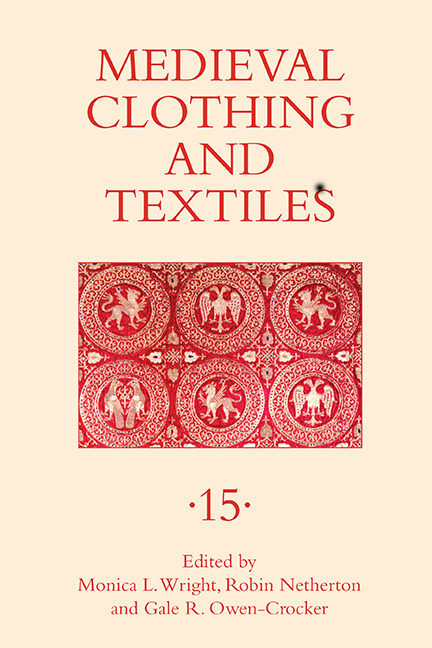Book contents
- Frontmatter
- Contents
- Illustrations
- Tables
- Contributors
- Preface
- 1 Old Rags, New Responses: Medieval Dress and Textiles
- 2 Text/Textile: “Wordweaving” in the Literatures of Anglo-Saxon England
- 3 Unfolding Identities: The Intertextual Roles of Clothing in the Nibelungenlied and Völsunga Saga
- 4 Clothing and Textiles at the Court of King John of England, 1199–1216
- 5 Dressing the Sacred: Medallion Silks and Their Use in Western Medieval Europe
- 6 Habit Envy: Extra-Religious Groups, Attire, and the Search for Legitimation Outside the Institutionalised Religious Orders
- 7 The Loom, the Lady, and Her Family Chapels: Weaving Identity in Late Medieval Art
- Recent Books of Interest
- Contents of Previous Volumes
1 - Old Rags, New Responses: Medieval Dress and Textiles
Published online by Cambridge University Press: 31 March 2021
- Frontmatter
- Contents
- Illustrations
- Tables
- Contributors
- Preface
- 1 Old Rags, New Responses: Medieval Dress and Textiles
- 2 Text/Textile: “Wordweaving” in the Literatures of Anglo-Saxon England
- 3 Unfolding Identities: The Intertextual Roles of Clothing in the Nibelungenlied and Völsunga Saga
- 4 Clothing and Textiles at the Court of King John of England, 1199–1216
- 5 Dressing the Sacred: Medallion Silks and Their Use in Western Medieval Europe
- 6 Habit Envy: Extra-Religious Groups, Attire, and the Search for Legitimation Outside the Institutionalised Religious Orders
- 7 The Loom, the Lady, and Her Family Chapels: Weaving Identity in Late Medieval Art
- Recent Books of Interest
- Contents of Previous Volumes
Summary
As the founder editors of Medieval Clothing and Textiles make a phased withdrawal and a new team takes over, it is an appropriate time to consider the ways in which our subject has developed, not just in the fifteen exciting years of our editorship but in the last half-century (coinciding with my own career); the current state of the art, including its historiography; and potential new directions. I make no claim to be encyclopaedic: My view inevitably reflects my own research experience and what I have learned from editing submissions to Medieval Clothing and Textiles and other collaborative volumes.
I begin with artefacts, commencing at the higher end of the social ladder and the later Middle Ages with surviving complete or near-complete garments, and continuing (by way of explaining the gender imbalances of our evidence) to the earlier material remains of textile and dress accessories from furnished graves in pre-and early Christian cemeteries and the organic remains (literally “rags”) from medieval occupation sites. I then consider representations of dress and textile in art and text before going on to examine theoretical approaches to the subject, giving particular emphasis to the usefulness of “object biography,” which privileges study of the long-term life of artefacts, including their reuse, modification, preservation, and display, an approach I have found particularly useful in my recent work in collaboration with Elizabeth Coatsworth. In following the continued existence of medieval textiles I consider why and how artefacts have survived and discuss ways of treating and displaying them. Finally, this article highlights some gaps and imbalances in our present knowledge and suggests possible future approaches.
A major development of the last half-century is that the subject has, rightly, become interdisciplinary. When I began postgraduate research into what was then called “Anglo-Saxon costume” this was not the case, and I had to discover the books, journals, and (where they existed) bibliographies for a whole range of different topics: archaeology, literatures, languages, manuscript art, stone sculpture, and ivory carvings. It is now much easier for specialists in one topic to access the work of those in other fields and to become cross-disciplinary in their own writing. New researchers do not have the time to reinvent the wheel.
- Type
- Chapter
- Information
- Medieval Clothing and Textiles 15 , pp. 1 - 32Publisher: Boydell & BrewerPrint publication year: 2019



